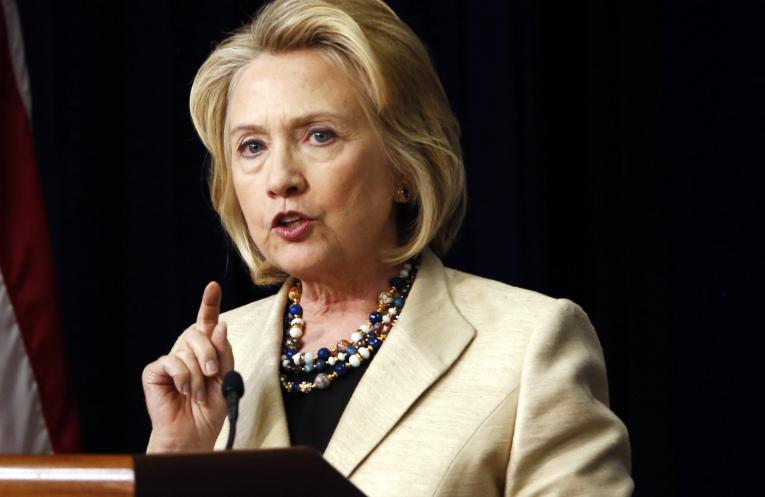By Patrick Martin
9 March 2018
Candidates from a military-intelligence background are seeking the Democratic Party nomination in 40 percent of the congressional districts targeted by the Democratic Congressional Campaign Committee in the 2018 elections. They make up the largest single occupational group running in the Democratic primaries. If the Democratic military-intelligence candidates won all 44 of the districts in which they are running—which is theoretically possible, if very unlikely—they would constitute, as a bloc, ten percent of the membership of the House of Representatives.
From the State Department to Capitol Hill
The final category of military-intelligence candidates consists of veterans of the US State Department during the Obama years, most of them former aides to Hillary Clinton. These are among the best financed and most publicized of the likely Democratic nominees. In the event of a Democratic “wave” in November, most would find themselves with seats in Congress.
Tom Malinowski, a former congressional aide and Clinton administration official, headed the Washington office of Human Rights Watch for 13 years before joining the Obama administration under Secretary of State John Kerry as assistant secretary of state for democracy, human rights, and labor. He is seeking the Democratic nomination in New Jersey’s 7th Congressional District against incumbent Republican Leonard Lance.
Lauren Baer was a legal adviser to both Secretaries Clinton and Kerry, as well as US Ambassador to the United Nations Samantha Power. She is now seeking the Democratic nomination in the 18th District of Florida, where her principal opponent is Pam Keith, a former judge advocate general in the US Navy and now general counsel to Florida Power & Light. Both women push additional buttons for identity politics, as Baer is openly gay and Keith is African-American.
Nancy Soderberg is a longtime US foreign policy figure going back to the Clinton administration, first at the National Security Council, then as deputy assistant to the president for national security affairs, then as an alternate US representative at the UN Security Council with the rank of ambassador. She has spent much of her time since then heading private overseas operations like the International Crisis Group, while playing a prominent role in the Florida Democratic Party. She is effectively unchallenged for the Democratic nomination in Florida’s 6th Congressional District (Daytona Beach), where the incumbent Republican Ron DeSantis is running for governor.
Edward Meier was a senior adviser to the State Department. According to his campaign website, he “was responsible for coordinating the military-to-civilian transition in Iraq—ensuring our diplomats and aid workers would be safe and secure after the withdrawal of US troops. In this role, he traveled to Iraq on multiple official trips working closely with the US military and the Iraqi government. …” He went on to be director of policy outreach for Hillary Clinton’s presidential campaign. Meier fell short Tuesday in his bid for the Democratic nomination in the 32nd District of Texas, finishing fourth out of five Democrats running against incumbent Republican Pete Sessions in a suburban Dallas district Clinton carried over Donald Trump, even though he spent the most money.
Sara Jacobs is another State Department official turned Clinton campaign aide, working on “conflict zones in East and West Africa,” particularly the campaign against Boko Haram in Nigeria, and helping to “spearhead President Obama’s efforts to improve governance in the security sector of our counterterrorism partners,” according to her campaign website. She was a foreign policy adviser to the Clinton campaign and is now seeking the Democratic nomination in California’s 49th District, where incumbent Darrell Issa is retiring.
Jacobs is the best-financed Democrat in the race, as befits the granddaughter of Qualcomm founder Irwin Jacobs, but at age 29 she would be the youngest congresswoman ever, and she has been snubbed in favor of several more experienced rivals by recent Democratic Party caucuses. One of her opponents is Douglas Applegate, a career Marine Corps judge advocate general with combat tours in Fallujah, Baghdad and Ramadi, who narrowly lost the 2016 race to Issa.
Talley Sergent, yet another State Department official turned Clinton campaign aide, is running in West Virginia’s 2nd Congressional District, which includes Charleston, against two-term incumbent Republican Alex Mooney. A former aide to Senator Jay Rockefeller, Sergent worked on slavery and sex trafficking at the State Department, then managed Clinton’s disastrous campaign in West Virginia before becoming a public relations executive for The Coca-Cola Co.
Challenging her for the Democratic nomination is Aaron Scheinberg, West Point graduate and Iraq War veteran, deployed first as a platoon leader in the 4th Infantry Division, then as a civil affairs officer in Haswah, Iraq. Scheinberg is now executive director of The Mission Continues, a nonprofit promoting the employment of veterans, whose board of directors includes such figures as Michele Flournoy, Pentagon undersecretary in the Obama administration; Meghan O’Sullivan, Iraq director for the National Security Council under George W. Bush; and retired General Ray S. Odierno, former commander of US forces in Iraq.
Jessica Morse was Iraq country coordinator for the State Department in the course of “over a decade as a national security strategist,” according to her website. She worked for the US Agency for International Development, a longtime CIA front, then as adviser to the US Pacific Command, where she “strengthened the US-India defense relationship … and worked to counter terrorist threats in South Asia.” Her opponent for the Democratic nomination in the 4th District of California, to face Republican incumbent Tom McClintock, is another former State Department officer, Regina Bateson, who was a vice-consul in Guatemala and “studied terrorist travel and border security,” according to her campaign website.
A stealth candidate—and some celebrities
The American corporate media has been slow to comment on the extraordinary influx of military and intelligence officers into the Democratic Party’s 2018 congressional campaign. The media prefers to cover the campaign from the standpoint of secondary characteristics, focusing on the great number of women running for office, mainly as Democrats, supposedly in response to Trump’s misogyny.
An exception to this pattern was the article February 8 by the Capitol Hill publication Roll Call, under the headline, “Active-Duty Candidates Can Run—But Can They Campaign?” The article profiled a Tennessee Democratic congressional candidate, Matt Reel, who was called up from his reserve status for a five-month deployment with the 20th Special Forces Group (Green Berets). According to the article, “Even Matt Reel’s staff doesn’t know where he’s deployed.”
Reel announced his campaign for the 7th District seat shortly after incumbent Republican Marsha Blackburn announced that she was leaving the House of Representatives to run for the US Senate seat from Tennessee currently held by Bob Corker, who is retiring. Because of the late announcements, the Democratic Congressional Campaign Committee has not yet targeted the district and Reel is not included in the figures cited earlier in this article.
The unusual situation for Reel is that, under Pentagon rules, he cannot direct his own campaign while he is on active duty. His aides and supporters can continue to campaign, but he is barred communicating with them in any way. Reel is not even allowed to tell them where he is, since the military deployment is covert. This truly “dark horse” candidate left his campaign having shot a few commercials and other video material, and will return a month or so before the August 2 primary.
Reel is one more example of a candidate from the “black ops” section of the military running as a Democrat. In his case, the two cannot be separated: he has been a Democratic Party functionary and a Green Beret since completing college. A former chief of staff to Alabama Representative Terri Sewell, his most recent position was deputy staff director for the Democrats on the House Veterans Affairs Committee.
While Reel is considered an extreme long-shot as a candidate, running in a district won by the Republicans in 2016 by a 3-1 margin, the DCCC is heavily promoting a number of career military candidates, most of them women, as star recruits for the most competitive districts in 2018, those where a switch from Republican to Democratic control is most likely. These candidates have access to funding far beyond what would be expected for first-time candidates without huge personal resources.
Running in the 31st District of Texas is Mary Jane Hegar, a helicopter pilot and certified military celebrity—Angelina Jolie is cast to play her in a biographical film based on her memoir, Shoot Like a Girl: One Woman’s Dramatic Fight in Afghanistan and on the Home Front. Hegar came to prominence through a lawsuit against the Pentagon policy of barring women from combat. Opposing her for the nomination to face incumbent Republican John Carter is Kent Lester, a West Point graduate and career military officer who retired as a lieutenant colonel after deployments to Panama and Bosnia, among other locations.
In Virginia’s 2nd District, which encompasses the Norfolk-Hampton Roads area with its complex of naval bases and shipyards, the DCCC has promoted Elaine Luria, one of the first Navy women to serve as an officer on a nuclear-powered ship, as its favored candidate under the “Red-to-Blue” program. Luria has “deployed six times to the Middle East and Western Pacific as a nuclear-trained surface warfare officer.” She was second-in-command of a guided missile cruiser and commanded assault craft supporting a Marine Corps deployment.
Other military candidates who had already raked in more than one million dollars in campaign funds in 2017, the year before the election, and have been widely publicized in local media in their districts, include:
Mikie Sherrill, a career Navy helicopter pilot, with ten years’ active service in Europe and the Middle East, now a federal prosecutor. She reported raising $1,230,000 by December 31, 2017 for her campaign for the Democratic nomination in New Jersey’s 11th Congressional District, where incumbent Republican Rodney Freylingheusen is retiring.
Chrissy Houlahan, a former US Air Force captain, has raised $1,228,000 for her campaign in Pennsylvania’s 6th Congressional District, against incumbent Republican Ryan Costello.
Amy McGrath, a career Marine fighter pilot with 89 missions in Iraq and Afghanistan, has raised $1,133,000 for her campaign in Kentucky’s 6th Congressional District against incumbent Republican Andy Barr.
Some political conclusions
There is growing popular hostility to the Trump administration, but within the political straitjacket of the two-party system, it is trapped without any genuine outlet. In November 2016, faced with the choice of equally repugnant ruling class figures—Hillary Clinton, the longtime stooge of Wall Street and the Pentagon, and Donald Trump, the corrupt billionaire from the financial underworld of real estate swindling and casino gambling—millions refused to vote. But disappointment and anger over the bankrupt, right-wing policies of the Obama administration led a sufficient number of working people to vote for Trump, particularly in devastated industrial states like Wisconsin, Michigan, Ohio, Pennsylvania and West Virginia, that he could eke out an Electoral College victory despite losing the popular vote.
The 2018 elections could well see a similar process, but in reverse. Angered by the tax cuts for the wealthy and big business, the gutting of social programs like Medicaid and food stamps, the attacks on immigrants and democratic rights more generally, and Trump’s threats of military violence and even nuclear war, millions of working people, however reluctantly, will go to the polls to cast their ballots for the official “opposition,” the Democratic Party, which does not actually oppose Trump at all.
It is by no means certain that the Democrats will win control of the House of Representatives in the 2018 midterm election on November 6. But the details presented in this report demonstrate that a Democratic victory would in no sense represent a shift to the left in capitalist politics.
In a sense, the Democratic Party’s promotion of a large number of military-intelligence candidates for competitive districts represents an insurance policy for the US ruling elite. In the event of a major swing to the Democrats, the House of Representatives will receive an influx of new members drawn primarily from the national security apparatus, trusted servants of American imperialism.
Parenthetically, it should be noted that there would be no comparable influx of Bernie Sanders supporters or other “left”-talking candidates in the event of a Democratic landslide. Only five of the 221 candidates reviewed in this study had links to Sanders or billed themselves as “progressive.” None is likely to win the primary, let alone the general election.
When the dust clears after November 6, 2018, there will almost certainly be more former CIA agents in the Democratic caucus in the House of Representatives than former Sanders activists. It is the military-intelligence operatives who constitute the spine of the Democratic Party, not the Sanders “Our Revolution” group. This is a devastating verdict on the claims of the Vermont senator, backed by various pseudo-left groups, that it is possible to reform the Democratic Party and push it to the left.
The preponderance of national security operatives in the Democratic primaries sheds additional light on the nature of the Obama administration. Far from representing a resurgence of liberal reformism, as apologists for the Democrats like the International Socialist Organization claimed at the time of his election, Obama’s eight years in office marked the further ascendancy of the military-intelligence apparatus within the Democratic Party.
This is demonstrated by the subsequent role of his top personnel. Among the former Obama civilian officials who are running in the Democratic primaries for seats in the House of Representatives, 16 served in the State Department, Pentagon, Department of Homeland Security or National Security Council, while only five served in domestic agencies. One of those, Haley Stevens, was chief of staff for the Obama auto industry task force, which imposed 50 percent wage cuts on newly hired auto workers. Among the five, only Stevens is considered a likely winner in the primary.
The Democratic Party has always been a party of the American capitalist class, and that means, from the dawn of the 20th century on, it has been a party of imperialism and imperialist war, whatever the occasional “peace” noises made by its candidates for the purpose of diverting and derailing mass antiwar sentiment among the American people.
For more than a century, a major political task of the Marxist movement in the United States has been to combat illusions in the Democratic Party, particularly those engendered by its comparatively brief periods of reformist politics, under President Franklin Roosevelt in the 1930s, and again during the Kennedy-Johnson years of the 1960s. The struggle against the Democratic Party, as well as the Republicans, remains the main focus of the effort to establish the political independence of the working class.
But the 2018 campaign represents something qualitatively different. Neither party offers any credible prospect of significant social reform. Both offer right-wing nostrums, laced with militarism, while seeking to split the working class along the lines of race, gender and national origin.
The campaign takes place in the wake of more than a year of unrelenting focus by the Democrats on the anti-Russian campaign, a narrative claiming that Trump’s victory in the presidential election was the result of Russian interference and that Trump is, for all practical purposes, a Russian stooge in the White House.
Not a shred of evidence has been provided either of Russian interference or of collusion with Russia on the part of the Trump campaign. Nor is there any suggestion that there was any significant element of fraud in either the vote or its tabulation by local and state governments.
But the Democratic Party has deliberately sought to whip up and appeal to the most right-wing, McCarthyite, chauvinist sentiments. It denounces Trump not for his right-wing policies, his immigrant baiting, his consorting with fascists and white supremacists, or his tax cut bonanza for the wealthy, but because he is allegedly insufficiently committed to confronting Russia militarily in the Middle East, Central Asia, Ukraine, Eastern Europe and the Baltic.
Clinton ran in 2016 as the favored candidate of the military-intelligence apparatus, amassing hundreds of endorsements by retired generals, admirals and spymasters, and criticizing Trump as unqualified to be the commander-in-chief.
This political orientation has developed and deepened in 2018. The Democratic Party is running in the congressional elections not only as the party that takes a tougher line on Russia, but as the party that enlists as its candidates and representatives those who have been directly responsible for waging war, both overt and covert, on behalf of American imperialism. It is seeking to be not only the party for the Pentagon and CIA, but the party of the Pentagon and CIA.
This is not merely a result of the political psychology or even the career paths of those who make up the upper echelon of the Democratic Party. It has a social and class character. The Democratic Party has long abandoned even a limited role as a party pledging social reforms in the interests of working people as a whole, in favor of the promotion of privileges for sections of the upper-middle class, doled out on the basis of identity politics.
The Democrat Party proposes a certain redistribution of wealth and power within the most privileged layer of the population, while leaving the essential social structure unchanged, with society divided between the super-rich at the top, a privileged upper-middle class, perhaps ten percent or less, and below them, the vast majority of working people, whose conditions of life continue to deteriorate as the economic “recovery” from the 2008 Wall Street crash approaches its tenth year.
The upper-middle-class layer that provides the “mass” base of the Democratic Party has moved drastically to the right over the past four decades, enriched by the stock market boom, consciously hostile to the working class, and enthusiastically supportive of the military-intelligence apparatus which, in the final analysis, guarantees its own social position against potential threats, both foreign and domestic. It is this social evolution that now finds expression on the surface of capitalist politics, in the rise of the military-intelligence “faction” to the leadership of the Democratic Party.











